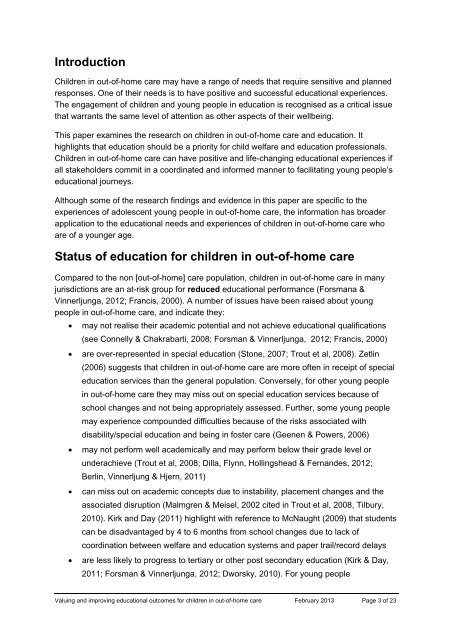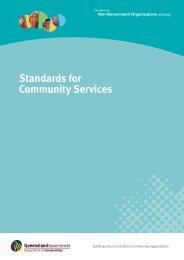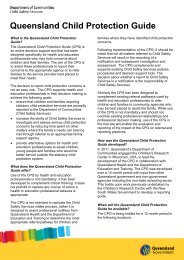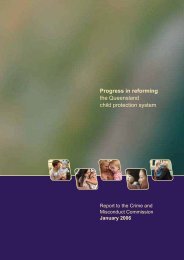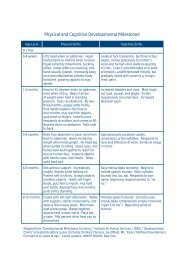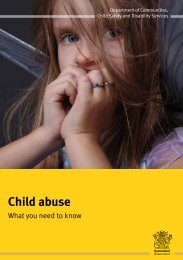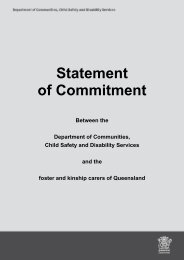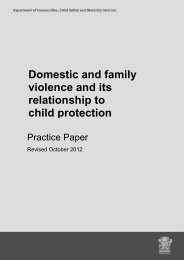Valuing and improving educational outcomes for children in out-of ...
Valuing and improving educational outcomes for children in out-of ...
Valuing and improving educational outcomes for children in out-of ...
You also want an ePaper? Increase the reach of your titles
YUMPU automatically turns print PDFs into web optimized ePapers that Google loves.
IntroductionChildren <strong>in</strong> <strong>out</strong>-<strong>of</strong>-home care may have a range <strong>of</strong> needs that require sensitive <strong>and</strong> plannedresponses. One <strong>of</strong> their needs is to have positive <strong>and</strong> successful <strong>educational</strong> experiences.The engagement <strong>of</strong> <strong>children</strong> <strong>and</strong> young people <strong>in</strong> education is recognised as a critical issuethat warrants the same level <strong>of</strong> attention as other aspects <strong>of</strong> their wellbe<strong>in</strong>g.This paper exam<strong>in</strong>es the research on <strong>children</strong> <strong>in</strong> <strong>out</strong>-<strong>of</strong>-home care <strong>and</strong> education. Ithighlights that education should be a priority <strong>for</strong> child welfare <strong>and</strong> education pr<strong>of</strong>essionals.Children <strong>in</strong> <strong>out</strong>-<strong>of</strong>-home care can have positive <strong>and</strong> life-chang<strong>in</strong>g <strong>educational</strong> experiences ifall stakeholders commit <strong>in</strong> a coord<strong>in</strong>ated <strong>and</strong> <strong>in</strong><strong>for</strong>med manner to facilitat<strong>in</strong>g young people’s<strong>educational</strong> journeys.Although some <strong>of</strong> the research f<strong>in</strong>d<strong>in</strong>gs <strong>and</strong> evidence <strong>in</strong> this paper are specific to theexperiences <strong>of</strong> adolescent young people <strong>in</strong> <strong>out</strong>-<strong>of</strong>-home care, the <strong>in</strong><strong>for</strong>mation has broaderapplication to the <strong>educational</strong> needs <strong>and</strong> experiences <strong>of</strong> <strong>children</strong> <strong>in</strong> <strong>out</strong>-<strong>of</strong>-home care whoare <strong>of</strong> a younger age.Status <strong>of</strong> education <strong>for</strong> <strong>children</strong> <strong>in</strong> <strong>out</strong>-<strong>of</strong>-home careCompared to the non [<strong>out</strong>-<strong>of</strong>-home] care population, <strong>children</strong> <strong>in</strong> <strong>out</strong>-<strong>of</strong>-home care <strong>in</strong> manyjurisdictions are an at-risk group <strong>for</strong> reduced <strong>educational</strong> per<strong>for</strong>mance (Forsmana &V<strong>in</strong>nerljunga, 2012; Francis, 2000). A number <strong>of</strong> issues have been raised ab<strong>out</strong> youngpeople <strong>in</strong> <strong>out</strong>-<strong>of</strong>-home care, <strong>and</strong> <strong>in</strong>dicate they: may not realise their academic potential <strong>and</strong> not achieve <strong>educational</strong> qualifications(see Connelly & Chakrabarti, 2008; Forsman & V<strong>in</strong>nerljunga, 2012; Francis, 2000)are over-represented <strong>in</strong> special education (Stone, 2007; Tr<strong>out</strong> et al, 2008). Zetl<strong>in</strong>(2006) suggests that <strong>children</strong> <strong>in</strong> <strong>out</strong>-<strong>of</strong>-home care are more <strong>of</strong>ten <strong>in</strong> receipt <strong>of</strong> specialeducation services than the general population. Conversely, <strong>for</strong> other young people<strong>in</strong> <strong>out</strong>-<strong>of</strong>-home care they may miss <strong>out</strong> on special education services because <strong>of</strong>school changes <strong>and</strong> not be<strong>in</strong>g appropriately assessed. Further, some young peoplemay experience compounded difficulties because <strong>of</strong> the risks associated withdisability/special education <strong>and</strong> be<strong>in</strong>g <strong>in</strong> foster care (Geenen & Powers, 2006)may not per<strong>for</strong>m well academically <strong>and</strong> may per<strong>for</strong>m below their grade level orunderachieve (Tr<strong>out</strong> et al, 2008; Dilla, Flynn, Holl<strong>in</strong>gshead & Fern<strong>and</strong>es, 2012;Berl<strong>in</strong>, V<strong>in</strong>nerljung & Hjern, 2011)can miss <strong>out</strong> on academic concepts due to <strong>in</strong>stability, placement changes <strong>and</strong> theassociated disruption (Malmgren & Meisel, 2002 cited <strong>in</strong> Tr<strong>out</strong> et al, 2008, Tilbury,2010). Kirk <strong>and</strong> Day (2011) highlight with reference to McNaught (2009) that studentscan be disadvantaged by 4 to 6 months from school changes due to lack <strong>of</strong>coord<strong>in</strong>ation between welfare <strong>and</strong> education systems <strong>and</strong> paper trail/record delaysare less likely to progress to tertiary or other post secondary education (Kirk & Day,2011; Forsman & V<strong>in</strong>nerljunga, 2012; Dworsky, 2010). For young people<strong>Valu<strong>in</strong>g</strong> <strong>and</strong> <strong>improv<strong>in</strong>g</strong> <strong>educational</strong> <strong><strong>out</strong>comes</strong> <strong>for</strong> <strong>children</strong> <strong>in</strong> <strong>out</strong>-<strong>of</strong>-home care February 2013 Page 3 <strong>of</strong> 23


